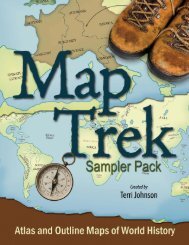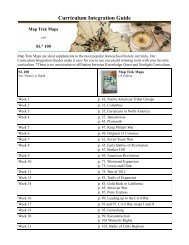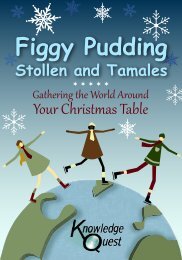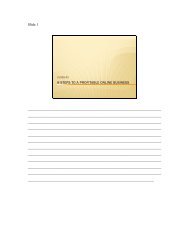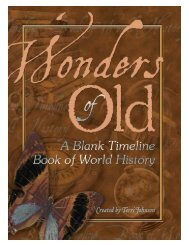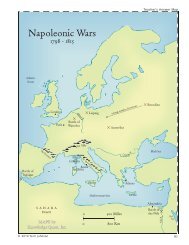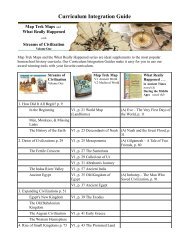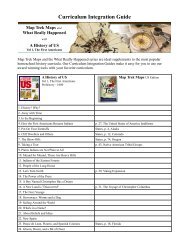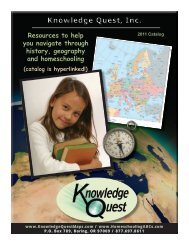Download the free New Zealand unit study here! - Knowledge Quest
Download the free New Zealand unit study here! - Knowledge Quest
Download the free New Zealand unit study here! - Knowledge Quest
Create successful ePaper yourself
Turn your PDF publications into a flip-book with our unique Google optimized e-Paper software.
Learning About our Globe<br />
One Country at a Time<br />
by Terri Johnson
y Terri Johnson<br />
Published by: Bramley Books, a division of<br />
<strong>Knowledge</strong> <strong>Quest</strong>, Inc.<br />
Post Office Box 789<br />
Boring, OR 97009-0789<br />
All rights reserved. However, <strong>Knowledge</strong> <strong>Quest</strong>, Inc. grants <strong>the</strong> right to<br />
<strong>the</strong> individual purchaser to reproduce <strong>the</strong> pages <strong>here</strong>in for noncommercial,<br />
individual use. Reproduction for an entire classroom, school or school<br />
system is strictly prohibited. Please call (210) 745-0203 or email orders@<br />
knowledgequestmaps.com for information on quantity sale discounts. No<br />
part of this book may be reproduced or transmitted in any form or by any<br />
means, electronic or mechanical, including photocopying, recording or by any<br />
information storage and retrieval system without written permission from<br />
<strong>the</strong> author.<br />
Copyright:<br />
2010 <strong>Knowledge</strong> <strong>Quest</strong>, Inc.<br />
and Terri Johnson<br />
www.<strong>Knowledge</strong><strong>Quest</strong>Maps.com<br />
www.BramleyBooks.com<br />
Printed in <strong>the</strong> United States of America<br />
ISBN 978-1-932786-35-4 (e-book)<br />
Cover design by Krystin Corneilson<br />
Page layout and design by Meredith Duke
Table of Contents<br />
How to Use this Book ........................................................................................................................... 4<br />
<strong>New</strong> <strong>Zealand</strong> - A Land Down Under .................................................................................................5<br />
Unit Study .........................................................................................................................................10<br />
Scotland - Learning in <strong>the</strong> UK ........................................................................................................... 17<br />
Unit Study .........................................................................................................................................21<br />
Poland - The Center of Europe ......................................................................................................... 29<br />
Unit Study .........................................................................................................................................33<br />
South Korea - Life in High Speed ......................................................................................................41<br />
Unit Study ........................................................................................................................................ 46<br />
South Africa - A Wild and Diverse Land ....................................................................................... 55<br />
Unit Study .........................................................................................................................................61<br />
Brazil - A Land of Contrasts .............................................................................................................. 70<br />
Unit Study .........................................................................................................................................75<br />
Canada - Our Friendly Neighbor ..................................................................................................... 82<br />
Unit Study ........................................................................................................................................ 89<br />
China - An Ancient Land ................................................................................................................... 95<br />
Unit Study ........................................................................................................................................ 99<br />
Israel - The Convergence of 3 Continents ....................................................................................108<br />
Unit Study ........................................................................................................................................113
How to Use this Book<br />
Dear Parents,<br />
If you are anything like me, <strong>the</strong>n <strong>the</strong>re are times when you and your children just need a break<br />
from <strong>the</strong> normal homeschool routine so that you can keep learning fresh and interesting. That is<br />
why this book of <strong>unit</strong> studies was written!<br />
Actually, it exists for two reasons and <strong>the</strong>se are:<br />
1. Most homeschooling families teach history, but very few teach geography.<br />
2. Many homeschooling families get stuck in a rut and may like to use an occasional <strong>unit</strong> <strong>study</strong> to<br />
pull <strong>the</strong>m back out!<br />
T<strong>here</strong> are nine complete geography <strong>unit</strong> studies included in Around <strong>the</strong> World - one for each month<br />
of <strong>the</strong> school year. Each one takes 1 week to complete and you can do <strong>the</strong>m in any order. So, <strong>here</strong> is<br />
how I suggest that you use this book:<br />
During a regular month of homeschooling, spend 3 weeks <strong>study</strong>ing history using your regular<br />
history curriculum, textbooks and read-alouds. On <strong>the</strong> 4th week, change it up by completing a<br />
1-week geography <strong>unit</strong> <strong>study</strong> on one of <strong>the</strong> countries featured in this book.<br />
You are <strong>free</strong> to cover <strong>the</strong> material any way that you choose, but an easy way to learn about each<br />
country has been suggested below:<br />
Monday – Read <strong>the</strong> chapter, plus do some additional reading from <strong>the</strong> recommended reading<br />
selections that are presented for you in <strong>the</strong> <strong>unit</strong> <strong>study</strong> section. You can find most of <strong>the</strong>se titles at<br />
your local library, so plan ahead by placing <strong>the</strong> titles on hold a week or two (or three) before you<br />
intend to use <strong>the</strong>m.<br />
Tuesday – Continue to read from <strong>the</strong> books that you picked up from <strong>the</strong> library, plus add some<br />
dates of historical significance to your history timeline. If you do not have one in <strong>the</strong> works, you can<br />
use <strong>the</strong> links provided to create and begin your timeline.<br />
Wednesday – Continue to read from <strong>the</strong> recommended reading selections and label significant<br />
geographical places on <strong>the</strong> unlabeled map of <strong>the</strong> country provided for you (use <strong>the</strong> teacher’s answer<br />
map or a globe as necessary).<br />
Thursday – Get into <strong>the</strong> kitchen and create some delicious dishes from <strong>the</strong> country that you are<br />
<strong>study</strong>ing. Recipes are provided for you in <strong>the</strong> <strong>unit</strong> <strong>study</strong> sections of each chapter.<br />
Friday – It is time to get out <strong>the</strong> glue (or whatever is required) and work on a craft from <strong>the</strong><br />
featured country. This is, of course, optional, but fun for <strong>the</strong> kids when you can take <strong>the</strong> time to<br />
make something to remember <strong>the</strong> country by. Alternatively, if you have older kids, you may want<br />
<strong>the</strong>m write a one page report about what <strong>the</strong>y have learned during your country <strong>unit</strong> <strong>study</strong>.<br />
If you have any questions, feel <strong>free</strong> to send me an email - terri@knowledgequestmaps.com. And,<br />
as always, remember to have fun!
Living and Learning in a Country Down Under<br />
Ah, <strong>New</strong> <strong>Zealand</strong>… a tiny<br />
island country known around <strong>the</strong><br />
world for its rugged beauty.<br />
With its inhabitants fondly<br />
referred to as “Kiwis” and its<br />
countryside as familiar as our<br />
own backyard, thanks to <strong>the</strong><br />
filming of The Lord of <strong>the</strong> Rings,<br />
<strong>New</strong> <strong>Zealand</strong> holds a special<br />
place in many of our hearts.<br />
But how much do you actually know about this country called <strong>New</strong><br />
<strong>Zealand</strong>? Have you ever learned about its history, terrain, location, government<br />
or culture? What would it be like to live <strong>the</strong>re… to homeschool <strong>the</strong>re? Let’s<br />
explore this island nation and find out.<br />
The Location<br />
<strong>New</strong> <strong>Zealand</strong> lies in <strong>the</strong> South Pacific Ocean nearly 2000 kilometers (or<br />
1,243 miles) to <strong>the</strong> east of Australia, and consists of two main islands – <strong>the</strong> North<br />
Island and <strong>the</strong> South Island. It also encompasses many smaller islands, such as<br />
Stewart Island and <strong>the</strong> Chatham Islands. Its closest neighbors to <strong>the</strong> north are<br />
<strong>New</strong> Caledonia, Fiji and Tonga.<br />
The capital city of Wellington and <strong>the</strong> largest city of Auckland are both<br />
located on <strong>the</strong> North Island, which has <strong>the</strong> more temperate climate. The South<br />
Island is <strong>the</strong> largest land mass and is divided along its length by <strong>the</strong> Sou<strong>the</strong>rn Alps,<br />
<strong>the</strong> highest point of which is Mt. Cook at 12,316 feet above sea level. In general,<br />
<strong>the</strong> country experiences high rainfall, particularly in winter, which lasts from June<br />
21 – September 22. Remember, <strong>New</strong> <strong>Zealand</strong> is in <strong>the</strong> sou<strong>the</strong>rn hemisp<strong>here</strong>!<br />
Page 5
The People<br />
Approximately 80% of <strong>the</strong><br />
What’s a Kiwi?<br />
population is of European descent. The<br />
The kiwi is a nocturnal flightless bird indigenous people group, called <strong>the</strong><br />
native to <strong>New</strong> <strong>Zealand</strong>. The kiwifruit Maori, makes up 15% of <strong>the</strong> population.<br />
(all one word) is a fuzzy fruit, also<br />
Polynesian settlers arrived sometime<br />
called <strong>the</strong> chinese gooseberry. To call<br />
<strong>the</strong> fruit a kiwi is offensive to a<br />
between <strong>the</strong> 13th and 15th centuries.<br />
growing number of <strong>New</strong> <strong>Zealand</strong>ers <strong>New</strong> <strong>Zealand</strong>’s Maori name, Aotearoa, is<br />
as <strong>the</strong> kiwi is <strong>the</strong>ir national bird and a<br />
strong symbol of this country. <strong>New</strong> usually translated as “Land of <strong>the</strong> Long<br />
<strong>Zealand</strong>ers are also affectionately White Cloud.” The first Europeans known<br />
known as Kiwis.<br />
to have reached <strong>New</strong> <strong>Zealand</strong> were led by<br />
Abel Tasman in 1642. He named <strong>the</strong><br />
islands Staten Landt, but Dutch cartographers changed <strong>the</strong> name to Nova<br />
Zeelandia. In <strong>the</strong> 1760’s, Captain James Cook mistakenly pronounced it <strong>New</strong><br />
<strong>Zealand</strong> and <strong>the</strong> name held fast. Cook’s extensive surveys of <strong>the</strong> islands led to<br />
European whaling expeditions and eventually significant European colonization.<br />
<strong>New</strong> <strong>Zealand</strong> has declared its independence in many shapes and forms over<br />
<strong>the</strong> years and now considers itself to be a sovereign constitutional monarchy<br />
within <strong>the</strong> Commonwealth of Nations. Basically, this means that <strong>the</strong>y recognize<br />
Elizabeth II as <strong>the</strong>ir Queen and head of state, but she has no active role in <strong>the</strong><br />
running of <strong>the</strong>ir government. The Governor-General, usually a native <strong>New</strong><br />
<strong>Zealand</strong>er, represents <strong>the</strong> Queen<br />
by carrying out her various<br />
responsibilities.<br />
In 1893, <strong>New</strong> <strong>Zealand</strong><br />
became <strong>the</strong> first nation to grant<br />
women <strong>the</strong> right to vote on <strong>the</strong><br />
same basis as men. Today, <strong>New</strong><br />
<strong>Zealand</strong> is <strong>the</strong> only country in <strong>the</strong><br />
Page 6
world in which all of <strong>the</strong> highest offices in <strong>the</strong> land have been occupied<br />
simultaneously by women.<br />
All around <strong>the</strong> world, <strong>the</strong> residents of <strong>New</strong> <strong>Zealand</strong> are nicknamed “Kiwis”<br />
and you may be wondering why. Although <strong>New</strong> <strong>Zealand</strong> exports 80 million trays<br />
of kiwifruit across <strong>the</strong> globe as one of its major exports, <strong>the</strong> name has no<br />
connection with <strong>the</strong> fruit. It derives <strong>the</strong> nickname from <strong>the</strong> country’s national<br />
bird, <strong>the</strong> kiwi, a flightless bird about <strong>the</strong> size of a domestic chicken. They have<br />
tiny two-inch wings which are essentially useless, and no tail. Despite its<br />
awkward appearance, a kiwi can actually outrun a human being. During <strong>the</strong> First<br />
World War, <strong>New</strong> <strong>Zealand</strong> soldiers carved a likeness of <strong>the</strong>ir national bird in <strong>the</strong><br />
chalk hill above Sling Camp in<br />
England. From that time forward,<br />
<strong>the</strong> <strong>New</strong> <strong>Zealand</strong> Servicemen were<br />
referred to by this nickname.<br />
Today, <strong>New</strong> <strong>Zealand</strong>ers overseas<br />
and at home are still invariably<br />
called “Kiwis.” Many sport teams<br />
from <strong>the</strong> islands carry <strong>the</strong> name<br />
proudly as well.<br />
Homeschooling<br />
The total population of <strong>New</strong> <strong>Zealand</strong> has now surpassed <strong>the</strong> four million<br />
mark. With over 6,428 homeschooling students from 3,415 families recorded by<br />
<strong>the</strong> Ministry of Education, this educational choice is embraced by approximately<br />
1% of <strong>the</strong> school-aged population. In order for <strong>the</strong> MOE (Ministry of Education)<br />
to grant an exemption to a child between <strong>the</strong> ages of 6-16 from attending a<br />
registered school, <strong>the</strong>y must be satisfied that <strong>the</strong> child will be “taught at least as<br />
regularly and as well as in a registered school.”<br />
Page 7
Cynthia, who lives in <strong>the</strong> small town<br />
of Foxton situated on <strong>the</strong> southwest coast<br />
of <strong>the</strong> North Island, states, “What this<br />
means exactly is open to a certain amount<br />
of interpretation. T<strong>here</strong> is no required<br />
curriculum that homeschoolers must<br />
follow, but we do have to submit a plan to<br />
<strong>the</strong> MOE that indicates our intentions for<br />
<strong>the</strong> education of our children; that we<br />
have an idea of w<strong>here</strong> <strong>the</strong>y are currently, w<strong>here</strong> <strong>the</strong>y need to go, and how we’re<br />
going to get <strong>the</strong>m <strong>the</strong>re.”<br />
Once <strong>the</strong> MOE approves <strong>the</strong> plan, homeschooling families have <strong>the</strong> option<br />
of receiving government funding for <strong>the</strong>ir educational endeavors. The amounts<br />
allotted to home educating families are $371.50 for <strong>the</strong> first child, $316 for <strong>the</strong><br />
second child, $270.50 for <strong>the</strong> third child, and $186 for each subsequent child.<br />
These amounts are paid every 6 months and have no strings attached, apart from<br />
submitting <strong>the</strong> signed and witnessed Statute of Declaration promising to carry out<br />
<strong>the</strong> mission stated above. The Ministry of Education believes that <strong>the</strong>re are<br />
probably few unregistered homeschooled students because of <strong>the</strong>se monetary<br />
incentives.<br />
“In general, homeschooling in <strong>New</strong> <strong>Zealand</strong> is a very positive experience.<br />
We have greater <strong>free</strong>dom to educate our children without interference than just<br />
about any o<strong>the</strong>r country,” Cynthia reports.<br />
Page 8
So, are you ready to move to <strong>New</strong> <strong>Zealand</strong>? Or at least take a<br />
vacation <strong>the</strong>re? Well, slow down… <strong>the</strong>re is some vocabulary you must learn if you<br />
intend to visit <strong>the</strong> country. Yes, <strong>New</strong> <strong>Zealand</strong>ers do speak English, but <strong>here</strong> are<br />
some of <strong>the</strong> slang words, or expressions that are commonly used, that you should<br />
know before stepping foot in <strong>the</strong> land of <strong>the</strong> kiwis:<br />
Well, you have now had a crash course on <strong>New</strong> <strong>Zealand</strong>’s history,<br />
geography and vibrant culture. Want to learn more? Turn <strong>the</strong> page for a fun <strong>unit</strong><br />
<strong>study</strong> on life in <strong>New</strong> <strong>Zealand</strong>.<br />
It is time to dive in for some hands-on learning to cement your student’s<br />
growing knowledge of this small but fascinating island country.<br />
Page 9
Unit Study<br />
1. READING SELECTIONS - Let’s start with some extra reading. Listed below are<br />
some great books about <strong>New</strong> <strong>Zealand</strong>, or set in <strong>New</strong> <strong>Zealand</strong>, that will provide<br />
many hours of enjoyable reading. The links below will take you to Amazon.com<br />
for more information, but you can find <strong>the</strong>se at your local library. Read for<br />
pleasure, or have your kids write a book report on one of <strong>the</strong>se selections.<br />
- The <strong>New</strong> <strong>Zealand</strong> Shake-Up by Stacy Towle Morgan<br />
- Australia and <strong>New</strong> <strong>Zealand</strong> by Elaine Landau<br />
- The Maori of <strong>New</strong> <strong>Zealand</strong> (First Peoples) by Steve Theunissen<br />
- <strong>New</strong> <strong>Zealand</strong> ABC (Country ABCs) by Schroeder, et. al<br />
2. HISTORY & TIMELINES - Learn more about <strong>New</strong> <strong>Zealand</strong> by compiling<br />
historical facts and events from <strong>New</strong> <strong>Zealand</strong>’s exciting history and adding<br />
<strong>the</strong>m to your timeline. If you do not have a timeline already started, you can<br />
construct one by following <strong>the</strong>se directions - How to Make a Timeline Easily.<br />
Here is a link to a wonderful resource for timeline entries about <strong>New</strong> <strong>Zealand</strong> -<br />
http://www.history-nz.org/timeline.html.<br />
3. MAPWORK - A <strong>unit</strong> <strong>study</strong> would not be complete without<br />
taking a good look at <strong>the</strong> lay of <strong>the</strong> land. Pages 15 and 16<br />
include both a labeled and unlabeled map of <strong>New</strong> <strong>Zealand</strong>.<br />
Have your students mark some of <strong>the</strong> major cities, <strong>the</strong><br />
sou<strong>the</strong>rn mountain range and <strong>the</strong> seas, at <strong>the</strong> least. For<br />
older students, have <strong>the</strong>m use your teacher’s map and fill in <strong>the</strong> rest!<br />
Page 10
4. RECIPES - This is my favorite part - <strong>the</strong> food from <strong>the</strong> land! If you do <strong>the</strong><br />
above activities on Monday, Tuesday and Wednesday, <strong>the</strong>n take some time on<br />
ei<strong>the</strong>r Thursday or Friday to whip up some au<strong>the</strong>ntic <strong>New</strong> <strong>Zealand</strong> cuisine in<br />
<strong>the</strong> kitchen.<br />
<strong>New</strong> <strong>Zealand</strong> cuisine is characterized by its freshness and diversity and has<br />
been described as Pacific Rim, drawing inspiration from Europe, Asia, Polynesia<br />
and its indigenous people, <strong>the</strong> Maori. Freshness is owed to its surrounding<br />
ocean and fertile lands. Its distinctiveness is more in <strong>the</strong> way <strong>New</strong> <strong>Zealand</strong>ers<br />
eat - generally preferring to be as relaxed and unaffected as possible.<br />
A Maori specialty is <strong>the</strong> hangi<br />
(pronounced hung-ee), a pit in which<br />
meats or fish are cooked with<br />
vegetables. A deep hole is dug in <strong>the</strong><br />
ground, lined with red-hot stones and<br />
covered with vegetation. The food is<br />
<strong>the</strong>n placed on top. The whole oven is<br />
sprinkled with water and sealed with<br />
more vegetation. The hole is <strong>the</strong>n filled<br />
with earth and left to steam for several<br />
hours. Traditionally, men dig and<br />
prepare <strong>the</strong> hole, and women prepare<br />
<strong>the</strong> food to go in it. All members of an<br />
extended family (whanau) help out for<br />
such a feast. The occasion is relaxed,<br />
friendly and fun, with people often eating <strong>the</strong> meal under a tent-like shelter.<br />
It may be difficult to pull off <strong>the</strong> above, but <strong>here</strong> are three more recipes of<br />
local <strong>New</strong> <strong>Zealand</strong> food that can be attempted in your own kitchen. Enjoy!<br />
Page 11
Page 12
Page 13
5. CRAFTS - Finally, it is craft time! This craft was chosen as a quick and simple<br />
one that represents <strong>New</strong> <strong>Zealand</strong>, its people and environment. The felt kiwi can<br />
be used as brooches or even fridge magnets.<br />
(Used with permission from Anne’s Guiding Pages - more NZ crafts can be found<br />
<strong>here</strong> - http://www.azmetro.com/nzcraft.html)<br />
Print off your kiwi pattern pieces <strong>here</strong> - http://www.azmetro.com/nzcraft1.html.<br />
Page 14
Teacher’s Answer Map<br />
Tasman<br />
Sea<br />
L. Te Anau<br />
Foveaux Strait<br />
Greymouth<br />
Mt. Cook<br />
Clutha R.<br />
S o u<br />
Mt. Aspiring<br />
L. Wakatipu<br />
Invercargill<br />
Auckland<br />
<strong>New</strong> Plymouth<br />
Karamea<br />
Bight<br />
Westport<br />
t h e r<br />
p s<br />
n A l<br />
Dunedin<br />
SOUTH<br />
ISLAND<br />
Canterbury<br />
Bight<br />
Wanganui<br />
Golden<br />
Bay<br />
Cook Strait<br />
Pegasus Bay<br />
Christchurch<br />
Whangerei<br />
Hauraki<br />
Gulf<br />
Waikato R.<br />
L. Taupo<br />
Bay of<br />
Plenty<br />
Hamilton<br />
Ruapehu<br />
Wellington<br />
NORTH<br />
ISLAND<br />
Hawke<br />
Bay<br />
Poverty<br />
Bay<br />
South<br />
Pacifi c Ocean<br />
new zealand<br />
Stewart Is.<br />
© 2010 Terri Johnson<br />
15
Student Map<br />
new zealand<br />
© 2010 Terri Johnson<br />
16






